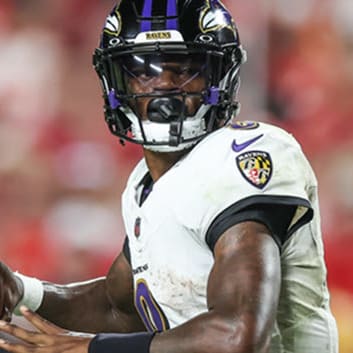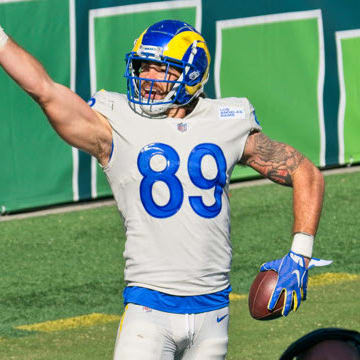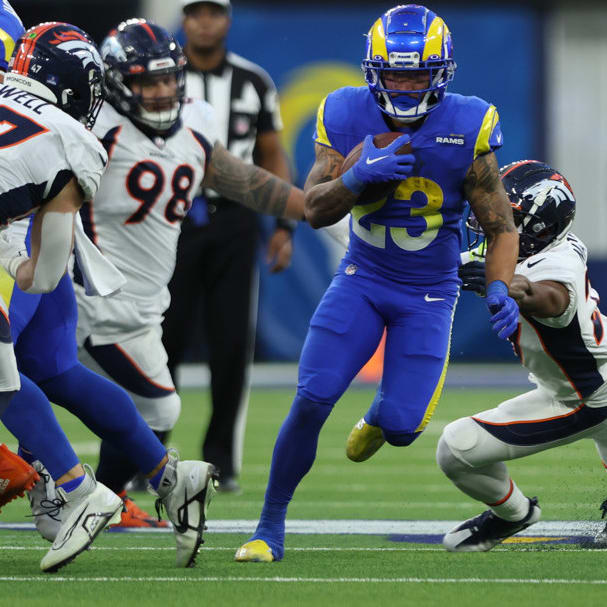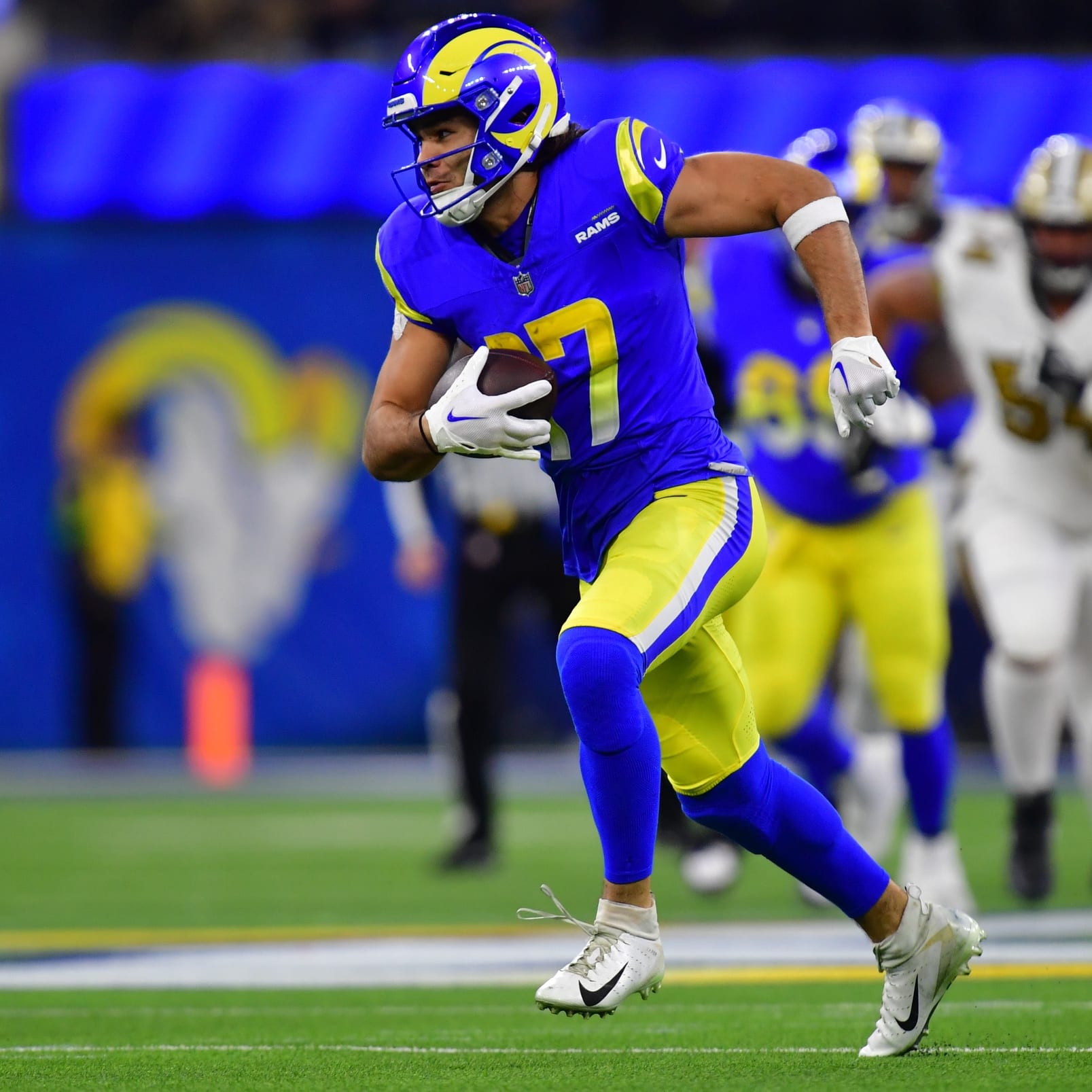This article is part of our NFL Draft series.
Already facing uphill battles in a typical NFL season, undrafted rookies in 2020 are stuck with the added challenge of the COVID-19 pandemic shutting down spring practices across the league. The UDFAs thus figure to have fewer chances to shine on NFL practice fields, but we can still pinpoint situations where there's room for an undrafted player to earn a job.
The Texans provide a good example, as their backfield doesn't have any 2020 draft picks and contains only two players with significant NFL experience, while the wideout room has fifth-round pick Isaiah Coulter joining a cast of six veterans that have started at least a handful of games. Given the circumstances, former Ole Miss running back Scottie Phillips has a shot to stick on the 53-man roster, whereas former Georgia wideout Tyler Simmons is simply aiming for the practice squad.
In addition to the current composition of a team's roster, contract details provide another hint as to which UDFAs are expected to challenge for roster spots or at least land jobs on practice squads. Each NFL franchise is limited to a $123,279 allotment for UDFA signing bonuses, but they can also provide salary guarantees to lure rookies away from other teams.
The track record of guaranteed money translating to NFL playing time is pretty good, with Tom Pelissero's 2018 list of top UDFA guarantees including RB Josh Adams, RB Darrel Williams, WR Vyncint Smith and WR Allen Lazard. None of those guys is a superstar by any means, but each has at least seen a few moments of relevance for DFS and deep dynasty leagues. Plus, Pelisserro's 2017 list included RB Matt Breida, RB Corey Clement and TE Blake Jarwin.
Last year, I put together my own list of the top UDFAs to monitor, noting that Dolphins wideout Preston Williams had "a good chance to stick on the 53-man roster" and could find his way to "regular snaps during the second half of the season". Technically, that was wrong, because Williams earned a starting job Week 1.
Other potential 'hits' included Raiders WR Keelan Doss and Jaguars RB Devine Ozigbo, while the 'misses' included James Williams and Emanuel Hall. It's inevitable that most of the guys mentioned will never end up making an impact in the NFL, but we can at least gain a degree of familiarity with those who are relatively more likely to achieve fantasy relevance.
Keep in mind that none of these players is worth drafting in a "standard" redraft league with 10-14 teams and 14-16 rounds. Even the success stories will usually need some time to develop before they see enough volume to warrant mainstream fantasy consideration. Williams in 2019 was a rarity — the perfect match between a guy that should've been drafted and a team that was sorely lacking in talent.
Running Backs
- James Robinson - Jacksonville Jaguars
I first took notice of Robinson when RotoWire prospect expert Mario Puig deemed the Illinois State product worthy of a late selection — admittedly very late — in our staff rookie mock draft. Robinson dominated FCS competition with three straight seasons of 1,000-plus yards and a dozen or more touchdowns, averaging 5.6 yards on 797 career carries and 7.4 yards on 58 receptions. A 4.64-second 40 time at the combine may have cost him a spot in the 2020 draft, but it was by no means a complete disaster for a player with his body type (5-9, 219).
Plus, Robinson did well in the other drills, finishing top 5 among RBs in the vertical jump (40 inches), broad jump (125 in.), bench press (24 reps), 3-cone drill (7.03 seconds) and short shuttle (4.19 sec.). SPARQ estimates from Three Sigma Athlete put Robinson in the 87th percentile among NFL running backs, good for fourth best in the 2020 rookie class (AJ Dillon - 96th, JaMycal Hasty - 90th, Jonathan Taylor - 89th). Granted, Robinson drops to the 52nd percentile (per Yahoo) for position-adjusted SPARQ, as his best marks from the combine came in drills with the weakest correlation to RB success in the NFL.
Initial data from OverTheCap.com suggests Robinson's signing bonus was only $5,000, which could mean he didn't find much of a market for his services, or could mean he accepted less to land in a favorable situation. It's hard to imagine a better opportunity than Jacksonville, where Leonard Fournette remains on the trade block and his backups are passing-down specialist Chris Thompson, 2019 fifth-round pick Ryquell Armstead and 2019 UDFA Devine Ozigbo. I will say that Ozigbo is a personal favorite of mine, and the Jaguars also signed two other undrafted RBs (Tavien Feaster, Nathan Cottrell), so it's not like anyone will be handed a roster spot. My best guess is an open competition between the handful of young RB to earn two or three spots.
- JaMycal Hasty + Salvon Ahmed - San Francisco 49ers
I already mentioned Hasty's outstanding SPARQ score (90th percentile, 70th adjusted), the product of a 4.55 40 time and 39-inch vertical jump in a 5-8, 205-pound frame. On a less promising note, his career at Baylor was unremarkable — 2,483 total yards, 16 TDs in four seasons — and he'll turn 24 in September. It's a different story for the 21-year-old Ahmed, who went over 1,000 yards for Washington last season but got stuck with a 27th percentile SPARQ score after running a 4.62 40 at 5-11, 197.
Spotrac.com shows Hasty getting $90k guaranteed to Ahmed's $50k, including a $15k signing bonus for the former and $10k for the latter. Remember that the Niners traded away Matt Breida, likely leaving Hasty, Ahmed, Jerrick McKinnon and Jeff Wilson to compete for two roster spots. The Niners kept four RBs on their 53-man roster for the majority of last season, finishing second in rush attempts (498) and yards (2,305) while deploying a backfield committee. We only need look to Breida to find an example of Kyle Shanahan successfully developing an undrafted runner.
- Michael Warren + Adrian Killins - Philadelphia Eagles
Warren is the highlight here, coming off a two-year stretch at Cincinnati with 2,594 rushing yards, 385 receiving yards and 36 touchdowns. He's 21 years old and listed at 5-11, 222, but he isn't especially fast or nimble, and a hamstring injury prevented him from working out at the combine, which became more of a problem when his pro day was cancelled.
Killins also had a respectable college career, but he never had the one big season, instead landing between 325 and 790 rushing yards each of his four years at UCF. After playing second fiddle to Otis Anderson in the Knights backfield last year, he wasn't invited to the 2020 combine. Listed at 5-8, 164, Killins essentially is the opposite of Warren, known for his breakaway speed, agility and lack of size. Killins averaged 12.3 yards on 70 receptions and 21.8 yards on 47 kick returns at UCF, providing a hint of how he might stick around in the NFL.
For the immediate future, Warren is probably a better fit for what the Eagles need and thus more likely to enter the fantasy conversation, potentially competing with Boston Scott, Corey Clement and Elijah Holyfield for depth work behind Miles Sanders. It's easy enough to draw a comparison between Warren and Clement, a 2017 UDFA who helped the Eagles win a Super Bowl his rookie season but has since been derailed by injuries.
If Sanders and Scott are the top two guys, it would make sense for the Eagles to prioritize size and power for their third RB. You might remember that Doug Pederson favored a three-back committee for much of 2017 and 2018, even stretching into 2019 until Darren Sproles suffered another injury.
Per Spotrac, Warren's contract includes a $7.5k signing bonus and $57.5k guaranteed, while details for Killins' aren't yet available. Warren is the one to keep an eye on for dynasty leagues.
- Darius Anderson + Rico Dowdle - Dallas Cowboys
I don't see a ton of reason to be excited about Anderson as a prospect, but his $110k guarantee (per Spotrac) is the largest that's been reported for any 2020 UDFA running back, so the Cowboys presumably think he's capable of winning the No. 3 job behind Ezekiel Elliott and Tony Pollard. The TCU product wants to be known as "Jet", which feels like an ironic nickname after he ran a 4.61 40-yard dash at the combine. He did well enough in the other tests to get a 78th percentile SPARQ score (60th percentile adjusted), so maybe it's his 128-inch broad jump that's supposed to remind us of an airplane?
The other guys competing for that No. 3 RB job are 2019 practice squadder Jordan Chunn and fellow 2020 UDFA Rico Dowdle, the latter coming off a four-year career as a committee back at South Carolina. It was Dowdle's freshman campaign that featured career highs for carries (133), rushing yards (764) and YPC (5.7), while his other seasons were wholly unremarkable.
He also put up good numbers at the combine, but his 81st percentile SPARQ score (74th percentile adjusted) might be lower if he hadn't skipped the agility drills and bench press. NFL teams won't usually be too excited about running backs with middling college production and a 4.54 40 time at 5-11, 213. Details on Dowdle's contract aren't available yet.
Note: the Cowboys also signed Anderson's college teammate Sewo Olonilua to a contract with $55k guaranteed, but the 232-pounder may be a fullback or strictly a special teams guy in the NFL.
- Scottie Phillips - Houston Texans
Phillips toes the line of being sub-NFL caliber (16th percentile adjusted SPARQ) in terms of measurables, and his modest $10k guarantee reflects that reality. On the other hand, he faces weak competition for the No. 3 RB job in Houston, where the only other guys behind David Johnson and Duke Johnson are special-teamer Buddy Howell and 2019 UDFA Karan Higdon. Not that I'd bet on Phillips winning that battle, but it's at least a realistic possibility. I'm a little surprised the Texans didn't see fit to bring in a better prospect like Robinson or Warren.
- LeVante Bellamy - Denver Broncos
Bellamy will turn 24 this summer and is undersized at 5-9, 192, but he's coming off back-to-back 1,000-yard seasons at Western Michigan, which helps explain how he received $60k guaranteed from the Broncos. While he's unlikely to ever be a workhorse, the Bronco-turned-Bronco could replace Royce Freeman as the No. 3 stallion in Denver. You'd like to see a RB this small do better than a 4.50 40 time, but Bellamy did at least put up good numbers in the vertical (39.5 in.) and broad jumps (125 in.). His 72nd percentile SPARQ score drops to a 14th percentile adjusted score, which seems to be penalizing him for skipping the agility drills.
- Tony Jones - New Orleans Saints
Jones is a similar case to Phillips, where the location seem more interesting than the player. The Saints are carrying only four running backs on their roster, with special teams ace Dwayne Washington handling the No. 3 role behind Alvin Kamara and Latavius Murray. Ozigbo couldn't unseat Washington last summer, but maybe Jones can pull it off if he looks good on special teams. The Notre Dame product had only one productive season in college, and his 4.68 40 time was ugly even for a 220-pound bruiser.
Wide Receivers
- Juwan Johnson + Marquez Callaway - New Orleans Saints
The Saints currently have 13 wide receivers on their roster, but they don't have any locks beyond Michael Thomas, Emmanuel Sanders and Tre'Quan Smith. Even the latter could eventually be bumped down the depth chart, having failed to develop as anything more than an occasional big-play threat.
At 6-4, 230, Johnson was a bit disappointing at both Penn State and Oregon, but his combine workouts were reasonably good for a big fella', including a 6.94-second three-cone time that tied for second best among WRs. You won't see many guys his size with that type of agility, and a 4.58 40 isn't bad for the body type. Unfortunately, Johnson finished his college career with only 1,590 yards, and he's already 23, so it's actually the lesser-known Callaway who appears more interesting.
The Tennessee product was only slightly more productive (1,646 yards), but he can at least point a finger at terrible QB play, whereas Johnson mostly worked with future NFL players Trace McSorley and Justin Herbert. Posting a 4.55 40, 38-inch vert and 126-inch broad jump at 6-1, 205, Callaway gets a 74th percentile raw SPARQ score and a 58th percentile adjusted score.
- Quartney Davis - Minnesota Vikings
Davis played two seasons at Texas A&M, catching 99 passes for 1,201 yards and eight TDs while finishing as the Aggies' second-leading receiver both years. Not exactly earth-shattering stuff, nor were his 4.54 40 time and 35.5-inch vertical at 6-1, 201. The 22-year-old is merely adequate in every regard, with the lack of an obvious shortcoming perhaps making him superior to his UDFA brethren. The Vikings apparently believe so, deeming Davis worthy of a $100k guarantee. That's a great outcome for an undrafted player, landing a nice chunk of money from a team that looks weak at his position. Nobody will be shocked if Davis earns the fourth or fifth WR job in 'Sota.
- Kalija Lipscomb - Kansas City Chiefs
With 4.57 speed in a 6-0, 207-pound frame, Lipscomb will need to be make his NFL living with toughness and technique rather than athleticism. But don't be surprised if he's able to pull it off, following a Vanderbilt career in which he caught 27 passes as a true freshman and 87 as a junior.
Lipscomb left Vandy with a career average of only 11.9 yards per catch after a disappointing senior campaign, but his lack of explosiveness won't be as much of a problem on a team that already has Tyreek Hill, Travis Kelce and Mecole Hardman. Long term, the Chiefs might be content with a third receiver who specializes in route running and blocking, serving as the possession option in an offense otherwise loaded with big-play threats.
Sammy Watkins and Demarcus Robinson are under contract for 2020, so the timeline for Lipscomb is 2021 and beyond. The Chiefs apparently have optimistic expectations, as Lipscomb's $110k guarantee is the largest that's been reported for any UDFA wide receiver this year.
- Omar Bayless - Carolina Panthers
With $100k in guaranteed money, Bayless ties the aforementioned Davis for the second-best deal among UDFA wideouts so far. The Arkansas State product was second in the FBS with 1,653 receiving yards last season, making his case for a Day 3 selection prior to a poor showing at the 2020 combine.
At 6-1, 212, the 23-year-old finished bottom six among WRs in the 40-yard dash (4.62), three-cone drills (7.35) and short shuttle (4.50), while his vertical (36.0 in.) and broad jump (123 in.) landed middle of the pack. The poor testing combined with a late breakout hints at limited upside, but his immense 2019 production suggests Bayless is at least good enough to compete for an NFL roster spot.
He did well to join a youth movement in Carolina, where the starting WR positions appear strong but the lower portion of the depth chart is scrub city. The Panthers likely will keep six receivers on their 53-man roster, and a rebuilding project should favor rookies over vets.
Tight Ends
- Thaddeus Moss - Washington Redskins
Moss had some pre-draft chatter as a potential fourth/fifth-round pick, perhaps getting a reputation boost from his NFL bloodlines. Randy's son even has a 570-yard season to his name, but 2019 represented his only significant collegiate action after a transfer and a medical redshirt, plus his production arguably becomes less impressive within the context of an LSU offense that put up 6,024 passing yards.
At 6-2, 250, Moss is short and thick for an NFL tight end, perhaps even profiling as an H-back. Unfortunately, we don't have any athletic testing numbers, as he chose to skip drills at the combine and later saw his pro day cancelled.
The good news is that Moss landed in Washington, home of the worst TE depth chart in the NFL. With Logan Thomas, Jeremy Sprinkle, Richard Rodgers, Hale Hentges and Caleb Wilson representing the other options, it appears to be a truly open competition — not only for roster spots but also for snaps. I wonder if Moss took a bit less money ($20k guaranteed, all from a signing bonus) to have a better shot at a job?
- Hunter Bryant - Detroit Lions
Bryant joins Moss as a frequent inclusion in mock drafts who didn't get a spot in the real thing. The main trait they have in common is suboptimal height, with the Washington product checking in at 6-2, 248.
Bryant may not look the part of an NFL tight end, but he did lead the Huskies in receiving yards (825) and yards per catch (15.9) as a junior last season, accounting for 26.1 percent of the team receiving total. Given that his combine testing was decent — 4.74 40, 32.5-inch vert, 115-inch broad jump, 23 bench reps, 7.08 three-cone, 4.46 short shuttle — I'm surprised Bryant wasn't drafted Day 3.
He should come in and compete for the No. 3 TE spot in Detroit, where 60k guaranteed suggests he can unseat 2019 seventh-round pick Isaac Nauta and 2019 UDFA Matt Sokol.
- Charlie Taumoepeau - Dallas Cowboys
I haven't seen contract details for Taumoepeau, a Portland State product who finished his FCS career with 117 catches for 1,876 yards (16.0 average) and 11 touchdowns. He did well at the combine with a 4.75 40 time, 36.5-inch vertical, 121-inch broad jump and 7.0-second three-cone drill, but he's another 'tweener prospect at 6-2, 240.
While there's nothing he can do about the height, Taumoepeau should have plenty of time to pack on pounds before he's needed in an NFL game. He may end up competing for a roster spot against fellow undrafted rookie Sean McKeon, who had 668 yards in four seasons at Michigan.
Kicker
- Rodrigo Blankenship - Indianapolis Colts
Kicker is the one position where it isn't all that rare for an undrafted rookie to earn a Week 1 starting job. Blankenship should provide tough competition for Chase McLaughlin, and also for Adam Vinatieri if the 47-year-old ends up re-signing with the Colts.
The Georgia product made each of his 200 PATs in college, also converting 82.5 percent of field-goal attempts and eventually winning the Lou Groza Award in 2019. Blankenship is one of just two undrafted kickers with a contract guarantee that's been reported, getting $20k from the Colts.












